A few years back I had the opportunity to explore the incredible island of Sri Lanka – its beaches, cities, and ancient sites. Of all the cultural stops I visited, the Sigiriya Rock Fortress struck me as one of the most impressive. Here is a brief intro to this inspiring destination.
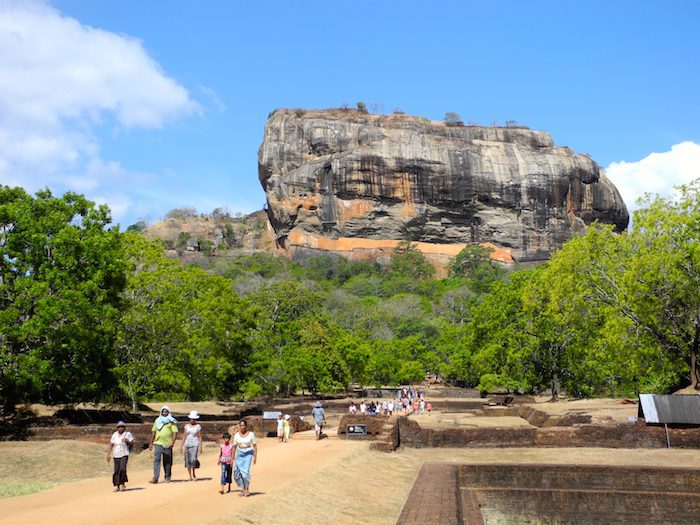
Sigiriya is an ancient city located approximately 100 miles (161 kilometers) northeast of Colombo, making the trip to this UNESCO World Heritage Site relatively short – about three hours by car. The Sigiriya Rock Fortress is an expansive royal compound that serves as a striking example of ancient urban planning. Elegant gardens, protective moats, graceful water fixtures, pathways, and unique frescos are just some features of the property. However, the icing on the cake is the royal palace on top of the giant boulder known as Lion Mountain or Sigiriya Lion Rock.
Also check out our article: The Ancient Cities of Sri Lanka
Buddhist monks originally lived and worshipped in the Sigiriya caves as early as fifth century B.C. Construction of the gardens and palace came much later during the rule of King Kassapa I, King of Ceylon (477 – 495 A.D.) King Kassapa was a ruthless monarch who had his father, King Dhatusena, killed, and older brother, Moggallana, overthrown so that he could rise to ultimate power.
The parricidal King Kassapa moved his capital from Anuradhapura to Sigiriya, where he built an opulent palace atop a giant 656-foot-high boulder. From there he ruled for nearly 11 years before being murdered by the brother he had cheated out of the throne. King Kassapa left behind a tangible legacy; a well-planned, stylish, and functional compound he created for his own enjoyment, and which fortunately can still be seen and enjoyed by visitors today.
A minimum of one full day is needed to explore the Sigiriya Rock Fortress. It is best to head over as early as possible to maximize time and beat the crowds. Be sure to wear airy clothing, sun block, and comfortable shoes. The Complex requires visitors to climb dozens of stairs and walkways to visiting Sigiriya lion rock and tour the palace. The site also requires extensive walking through the paths that wind through the royal gardens.
Hours of Operation: Buses run daily from 6:30 a.m. to 6:00 p.m.
Admission: 3600 LKR

On the western section of the rock, about 100 meters from the base, are the fifth century frescos of the Sigiriya maidens. There are currently 50 frescos remaining, but originally there were 250 depicting 500 maidens. This fact was uncovered thanks to the graffiti along the kat bitha (mirror wall) describing the scenes. It is unclear whether the king’s daughters or sizeable harem were the subjects of these vibrant frescos of bare-breasted women, but the fact that they have been popular focal points at Sigiriya for centuries is inarguable (think ancient Playboy).
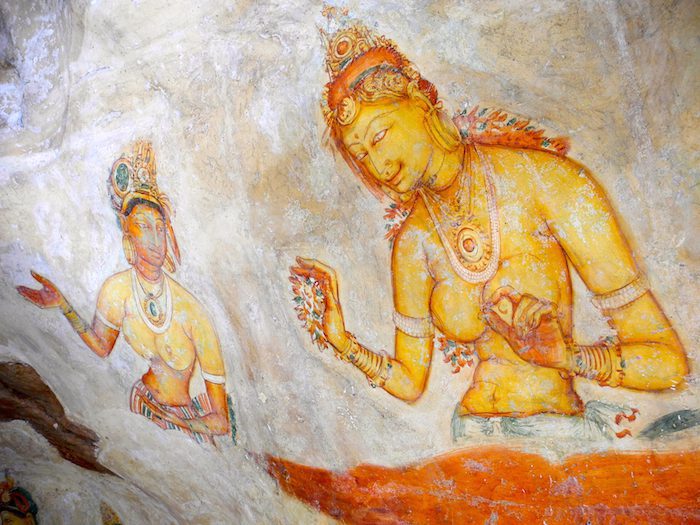
The maidens are depicted wearing bright colored clothing, elaborate headdresses and jewelry, and carrying platters of fruit and floral bouquets. They represent “apsaras” or celestial nymphs, a common theme in religious and royal art of South Asia. Each maiden has a serene, joyful expression. Traces of plaster and paint suggest that a large portion of Lion Mountain’s western façade was decorated with these colorful, erotic frescos.
The Sigiriya site contains oldest landscaped water, boulder, and terraced gardens in the world. The water gardens feature dozens of remarkable water fixtures designed with both beauty and functionality in mind. Like the bathing pools of Anuradhapura’s Abayagiri Vihara monastery, each pool at Sigiriya has its own purpose is representative of the hydraulic ingenuity and mastery of the time. Upon entering through the elaborate western entrance, also known as the “royals’ entrance,” visitors will come across the inner moat. It was used as a protective barrier against invasions. Under the delicate lotuses swam dozens of crocodiles, just in case an attacker tried to swim across…
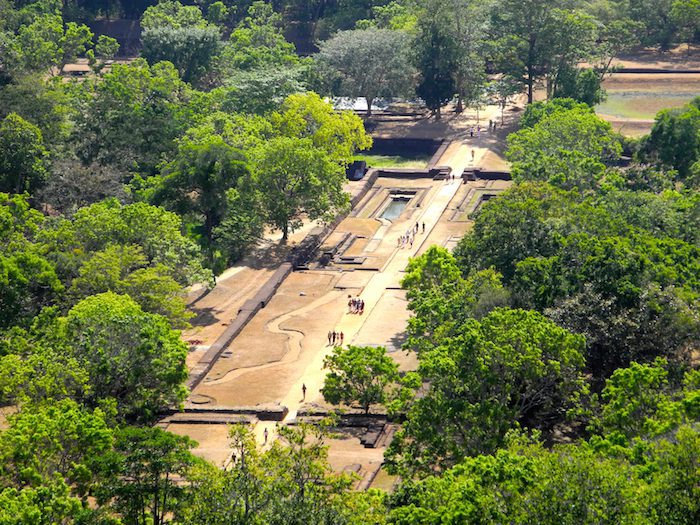
To the right of the entrance, just south of the inner moat, is the miniature water garden, a series of shallow square pools originally purposed for aesthetic charm. The soothing sounds of water compliment one’s royal garden experience. The large bathing pools are just as romantic. A third water garden is located on a higher level. It holds an octagonal bathing tank complete with a drip ledge feature, which was quite the opulent design element for the time. While touring this imaginative complex it isn’t difficult to envision the splendor that once was Sigiriya’s water gardens. The pools’ positions were planned with precision in a symmetrical pattern that is both functional and pleasing to the eye. They were built with clay, brick, granite, and marble, and feature complex drainage and pump systems.
 The bathing pools are truly a royal piece of work for a king and his harem. The boulder garden incorporates natural massive stone with man-made winding pathways that weave in and out of giant cracks. Before and after the age of King Kassapa, Buddhist monks used Sigiriya as a monastic complex until the fourteenth century. The boulder garden features original structures from the fifth century B.C. monks as well as additions made by the monks who lived there during the post-Kassapan era. The terrace gardens are a collection of tiered wall gardens following the natural slope of the landscape. They lead straight to Lion Gate at the base of Sigiriya lion rock. Southwest of the rock fortress, at the base of a rock that looks like a cobra head, is the Cobra Hood Cave. Once part of the Sigiriya monastery, Cobra Hood Cave has millennia-old paintings on. Pidurangala rock and Sigiriya lion rock are two popular places.
The bathing pools are truly a royal piece of work for a king and his harem. The boulder garden incorporates natural massive stone with man-made winding pathways that weave in and out of giant cracks. Before and after the age of King Kassapa, Buddhist monks used Sigiriya as a monastic complex until the fourteenth century. The boulder garden features original structures from the fifth century B.C. monks as well as additions made by the monks who lived there during the post-Kassapan era. The terrace gardens are a collection of tiered wall gardens following the natural slope of the landscape. They lead straight to Lion Gate at the base of Sigiriya lion rock. Southwest of the rock fortress, at the base of a rock that looks like a cobra head, is the Cobra Hood Cave. Once part of the Sigiriya monastery, Cobra Hood Cave has millennia-old paintings on. Pidurangala rock and Sigiriya lion rock are two popular places.
King Kassapa had the famous kat bitha, made to suit his decadent tastes. The wall of the gallery is made of brick, with a shiny, reflective coat of egg white wash and porcelain. Many believe that this reflective surface was designed to help the king see his reflection as he passed through.
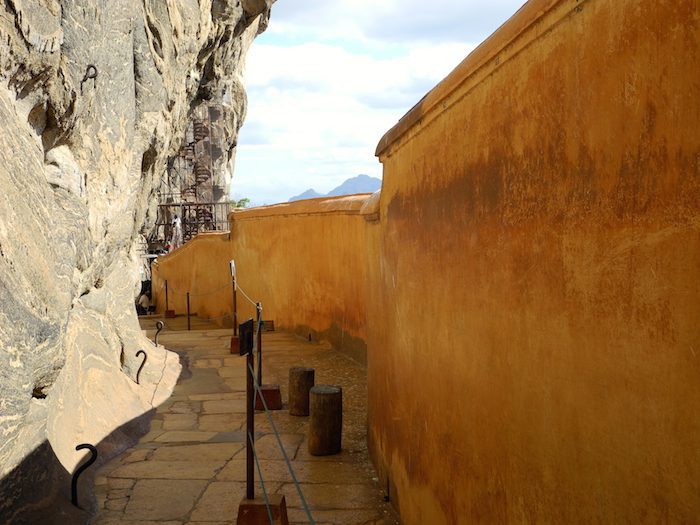
Remarkably, thousands of years later, the wall has retained its sheen. Perhaps just as famous as the wall, is the ancient graffiti scribbled onto it. There are over 1,000 poems, statements, and messages on the mirror wall, with some dating back to the sixth century. The graffiti shows that people have been visiting Sigiriya complex for centuries. Examples include poetry about the beautiful landscape and comments about the lovely maidens depicted at the frescos.
After exploring and visiting Sigiriya intricate gardens, caves, and infamous mirror wall, visitors will finally arrived at the Lion Mountain platform – a stairway flanked by a pair of ominous clawed lion paws.
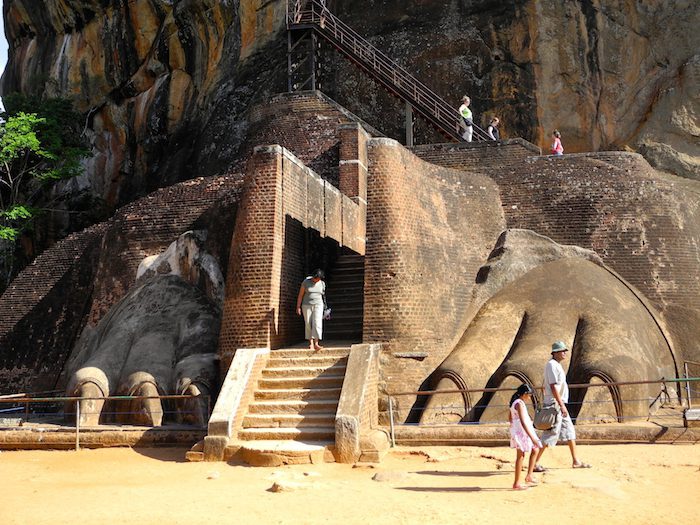
As is true for other cultures around the world, the ancient Sinhalese conceptualized the lion as a symbol of power and strength. The stairway once directed royals into the mouth of the beast, but unfortunately the paws of the great Sigiriya lion are all that remain today. Past the talons, visitors climb Sigiriya rock the seemingly endless steps that ascend Lion Mountain.

After conquering the winding spiral staircases, limestone steps, and acres of garden, you will reach the summit of Sigiriya rock. Once at the top, relax and savor the unmatched panoramic views while snapping photos of yourself at the 1,200th step! Here stood the royal complex, complete with bathing pools (yes, there are more), royal chambers, and throne. Once you reach the top you will understand why Sigiriya is often referred called the “palace in the sky.”
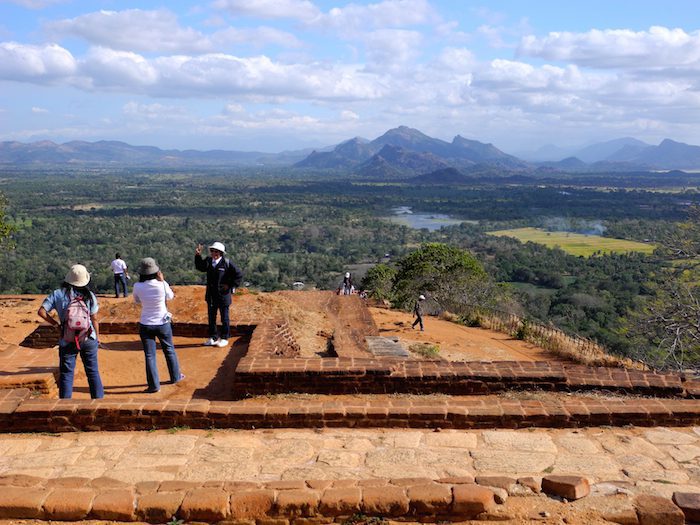
Afterwards, all visitors are invited to enjoy the Sigiriya Museum, which houses a visitor’s information center, on site conservation laboratory, and research center. The Sigiriya museum was gifted by the Japanese government to help visitors understand the historical and religious significance of ancient Sigiriya.
Watch the episode on Sigiriya Rock Fortress
Dambulla is a scenic town situated 91 miles (148 kilometers) northeast of Colombo and 12 miles (20 kilometers) southwest of Sigiriya. The town’s main attraction is the Dambulla Cave Temple, or “Golden Temple.” There are cave temples throughout Sri Lanka, but the cave temple complex in Dambulla is the best preserved in the country, which earned it a place on the UNESCO World Heritage Site list.

Since the third century B.C., Buddhist monks have used the Dambulla caves for worship, but these cavernous dwellings also provided refuge for King Valagamba during his exile. King Valagamba was the rightful king of Anuradhapura, but was forced to hide out in Dambulla after being overthrown by invaders from Southern India. He eventually regained the throne in 89 B.C. and commissioned the construction of the Abhayagiri Vihara Buddhist Monastery in Anuradhapura. The monastery’s original dagoba, or stupa, can still be seen today. A stupa is a mound-shaped Buddhist structure that represents the Buddha and the path to enlightenment. Dambulla is also home to the famed International Cricket Stadium. Located just west of the Golden Temple complex, Dambulla’s cricket stadium was built in only 167 days and has hosted international cricket matches since opening in 2001.

The Dambulla Cave Temple is actually a system of caves comprised of five intact cave shrines that feature statues, murals, and other religious works of art dating between the first century B.C. and 1250 A.D. Visitors will first encounter Devaraja Lena, or Cave of the Diving King. It features a 14-meter-long statue of the sleeping Buddha carved out of solid rock. At his head rests the god Vishnu, and at his feet, a statue of his pupil,. A Brahmi inscription over the cave’s entrance provides an account of the founding of the monastery.

With a height of seven meters, the Cave of the Great King, or Maharaja Lena, is the largest in the complex. It houses 56 statues of the Buddha, statues of two Sinhalese kings, and ceiling murals depicting scenes from the Buddha’s life and path to enlightenment. The third cave visitors will encounter is the New Great, or Maha Alut Viharaya. It features 50 gilded statues of the Buddha and is decorated in traditional Kandyan style.
 The fourth cave, Paschima Viharaya, is smaller than the others and has a miniature dagoda in its center. The fifth and final cave, known as the Second New Temple, or Devana Alut Viharaya, is the newest cave in the complex. It contains a reclining Buddha and images of Hindu deities. As with all other religious sites in Sri Lanka, guests are to dress conservatively. No hats, short skirts, or sleeveless tops. Shoes must be removed before entering.
The fourth cave, Paschima Viharaya, is smaller than the others and has a miniature dagoda in its center. The fifth and final cave, known as the Second New Temple, or Devana Alut Viharaya, is the newest cave in the complex. It contains a reclining Buddha and images of Hindu deities. As with all other religious sites in Sri Lanka, guests are to dress conservatively. No hats, short skirts, or sleeveless tops. Shoes must be removed before entering.
Hours of Operation: Daily from 7:30 a.m. to 7 p.m.
Admission: 1500 LKR

The ancient city of Polonnaruwa is a UNESCO World Heritage Site located about 17 miles (27 kilometers) from Sigiriya. With Sigiriya and Anuradhapura, Polonnaruwa forms part of Sri Lanka’s “cultural triangle.” Polonnaruwa’s ancient city is approximately two square miles of ruins dating back to the first and 12th centuries, with some dating back even earlier. Touring the ruins of Polonnaruwa will reveal the late period of ancient Sinhalese society and Buddhist tradition in Ceylon. Control of Polonnaruwa, Ceylon’s second most ancient kingdom, shifted when King Vijayabahu I defeated the Cholas, Hindu invaders from India, in 1070 A.D. The king’s grandson Parakramabahu I is credited with spearheading Polonnaruwa into its golden age during the 12th century.

Under King Parakramabahu, Polonnaruwa became an urban wonder with irrigation systems far more advanced than those in Anuradhapura. Lake Parakrama, also called the “Sea of Parakrama,” is a prime of a successful ancient water conservation project. Lake Parakrama is a massive man-made reservoir with an area of 14 square miles, or 22.6 square kilometers. It is located just west of the ancient city. King Parakramabahu undoubtedly set the standard for his successor, King Nissamkamalla. Polonnaruwa eventually grew in size and wealth in the following years. By 1196, the Polonnaruwa was adorned with gardens, royal palaces, stupas, and enormous rock sculptures.
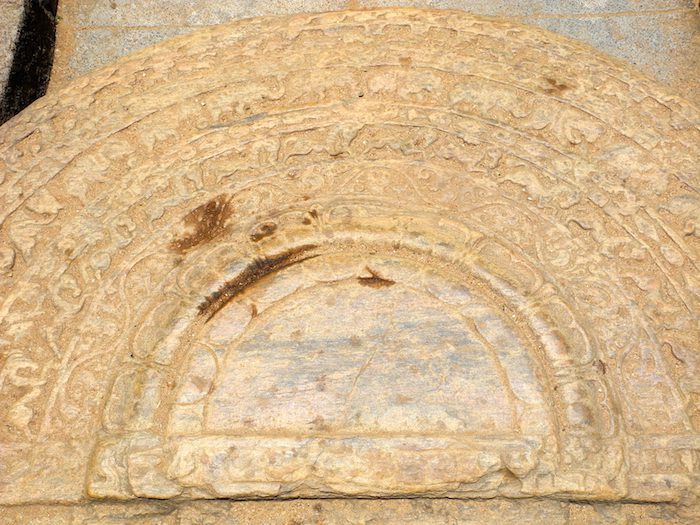
A minimum of one full day is required to see the Polonnaruwa ruins, especially if you plan to tour the area on foot. Numerous visitors choose instead to rent bicycles (200 to 250 LKR, or about $2 per day) from local guesthouses. This is an easy and cheap way to maximize on time mainly because the trails are clearly labeled and run from north to south in both directions. Tickets are sold at the Polonnaruwa Museum and Sigiriya Museum. Each ticket is valid for one day and another ticket must be bought to return the following day. It is advisable to dress comfortably, bring a hat, and get an early start to avoid the heat as long as possible.
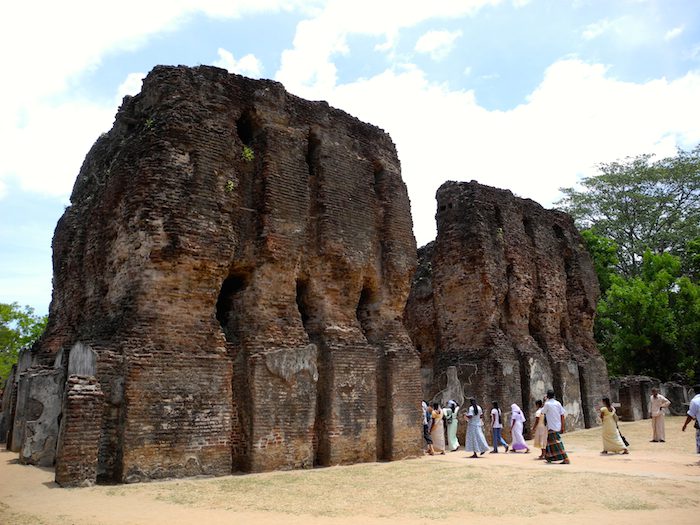
After purchasing tickets at the Polonnaruwa Museum, be sure to get a map at the information center. Follow the trails to visit Sigiriya King Parakramabahu’s ancent palace, council chamber, and elaborate royal bath. Afterwards, make your way to the monuments, shrines, stupa, guard stones, and the famed moonstone, Vatadage, built by King Vijayabahu I in the 11th century. The northernmost part of the city features Polonnaruwa’s largest monuments: the Rankot Vihara stupa, the four giant carved statues of the Buddha at Gal Vihara, and the colossal (headless) statue of Buddha at the Lankatilaka shrine. We advise hiring a guide at the entrance to show you around the site. A tour of the ancient city will set you back about 2800 – 3000 LKR, about the same as the price of admission.

Hours of Operation: Daily from 7 a.m. to 6 p.m.
Admission: 2800 LKR
Matale is located about 33 miles (54 kilometers) south of Sigiriya, or about 45 minutes by car along the Kandy-Jaffna Highway. Situated in Sri Lanka’s hill country, an agricultural region that produces spices and vegetables, lies the small, quiet town of Matale with a history that is anything but lackluster. British colonial occupation had spread throughout Sri Lanka by the mid-nineteenth century. The British controlled the Kandyan provinces for 32 years until the fateful Matale Rebellion changed the course of history for Sri Lanka.

On July 26th 1848, Puran Appu and Gongalegoda Banda led a peasant revolt against the colonists that had disenfranchised their people for far too long. Earlier that month, the British had imposed heavy taxes, forced peasants to raise coffee crops for export to Britain, and shipped in laborers from India (Tamils) to do the work for less pay. To this day, both Appu and Banda are regarded as national heroes for their bravery and willpower. Their efforts marked the beginning of Sri Lanka’s modern struggle for independence.
Aside from its historical significance, Matale is also home to the Aluvihara Cave Monastery. Like the caves in Dambulla, the Matale shrines house colorful depictions of the Buddha, with the most impressive being the 10-meter long reclining Buddha statue. Ominous multihued paintings on the cave walls show demons torturing and punishing people for their sins. On the second level there is a cave dedicated to Buddhaghosa, the man who many Buddhists believe wrote down the Pali Canon, or “Tipitaka”, on palm leaves. The Pali Canon is an ancient collection of Theravada Buddhist scriptures that describes rules for monks and nuns, Buddha’s teachings, and philosophies about the nature of the mind, time, and matter. The Aluvihara Cave Monastery is open daily from 7 a.m. to 6 p.m. Admission is 100 LKR.

The Sri Muththumari Hindu Temple is also found in Matale. The exterior of this unique and flamboyant structure features dozens of carved animals, gods, and Hindu deities. Upon entering, you will encounter dozens of statues of deities and animated frescos. Worshippers make offerings of flowers and fruits. Tamils are people of Indian descent who were brought to Ceylon (mainly by the British) during the 19th and 20th centuries as agricultural laborers. The Tamil people erected several Hindu temples like the one in Matale.
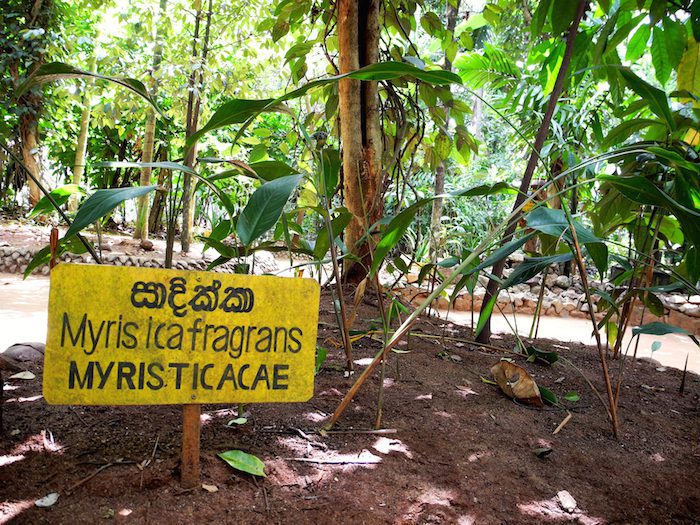
A spice garden tour is a must-do while visiting Matale. The Ranweli Spice Garden gives quick guided tours through a botanical garden to view several plant species such as pepper, red chocolate, and vanilla. Visitors will learn about their uses in the worlds of cooking, cosmetics and medicine. Once the tour finishes, visitors are invited to visit the store with several well-priced spices, powders, and ointments. The Ranweli Spice Garden is open daily from 8 a.m. to 5 p.m. Tours are free.
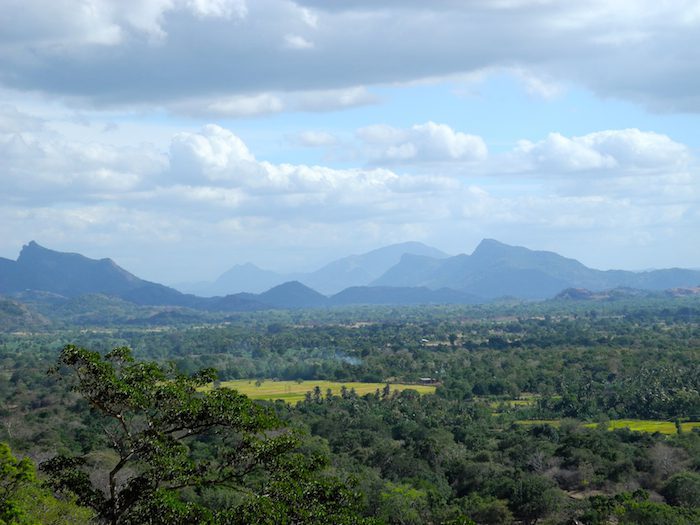
Sigiriya is a fascinating place with a colorful history. It is amazing to think how an ancient society produced such exquisite examples of hydraulic mastery. It is important to know that the water garden probably will not be watery at all. They stay dry during the summer months because they function with the arrival of rainwater.
Like Dambulla and Polonnaruwa, exploring Sigiriya requires climbing, walking, as well as a tolerance for potentially high temperatures. This is why it is best to come in the morning, wear comfy clothes, and stay hydrated! The trek is worth it once you get to the top of Sigiriya lion rock and take in the extraordinary view. Along the way, you may find juice vendors, snake charmers, and monkeys to entertain you as you go. While typically only one day is needed in Sigiriya, Matale and Dambulla, you may need an extra half or full day in Polonnaruwa to properly explore the ancient city there. The Sri Muththumari Hindu Temple in Matale is like no other I have seen.
The elaborate figures on the exterior of the temple are beautiful and mysterious. When you finish there, do not miss a spice garden tour. Apart from the one recommended in this guide, there are many places offering similar services. Sigiriya, Polonnaruwa, and Anuradhapura comprise the “cultural triangle” of Sri Lanka. Each has its own charms, but Sigiriya is different; a true testament to one man’s love of power and pursuit of lavishness.
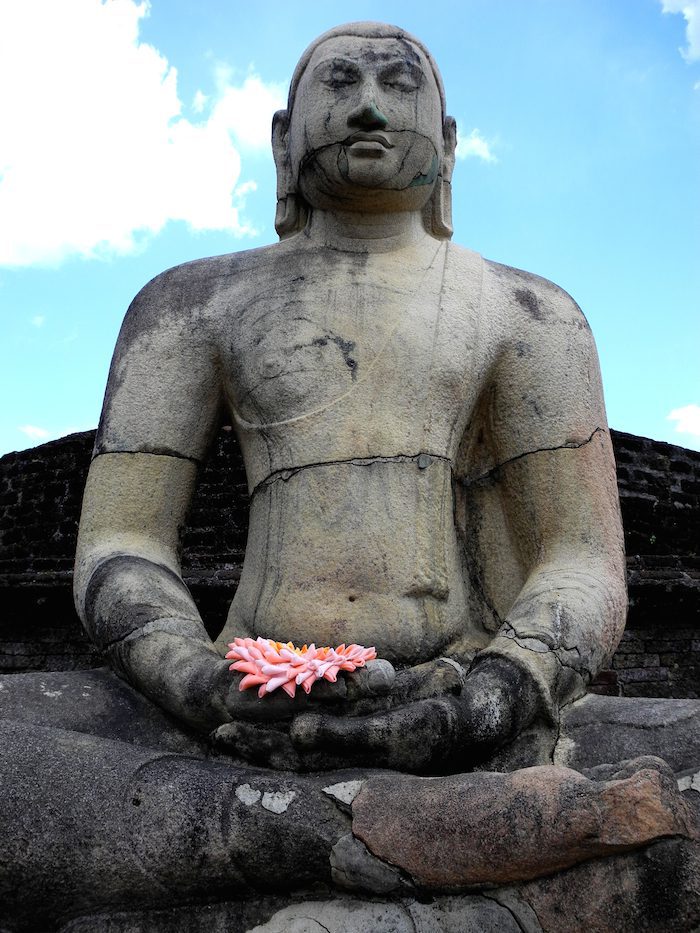
Time zone: GMT +5:30 hours (Indian Standard Time)
Capital city: Colombo
Languages spoken: Sinhalese, Tamalese and English
Currency: Sri Lankan rupee (LKR)
Currency converter: www.xe.com
Getting around: When traveling between cities, buses and trains are best. Buses can be really crowded and are seldom air-conditioned. Though trains are slower and can be crowded as well, they often considered the more comfortable mode of transportation. When in the city, tuk-tuks, buses, taxis, and, in many cases, simply walking, are all viable forms of transportation. In some cases, cars and drivers can be hired for a day or bicycles can be rented.
Shopping: There are a handful of craft shops along the road from Habarana to Sigiriya selling handmade furniture, masks, and other decorative items.
Tipping policy: Service fees, typically 10%, are included at most restaurants. Drivers and guides will also expect tips. A tip of 50 LKR is acceptable for hotel doormen and the people who collect guests’ shoes at the temple.
Electricity: There are two types of sockets, the Type D Indian 5 amp BS-546 and the European CEE 7/16 Europlug.
Best time to go: Sri Lanka has two monsoon seasons, which means your trip does require some pre-planning. The dry season in the south western area of the country is between December and March. The dry season in the northern and eastern sections of the country lasts from May to September. Between October and November, sporadic rains occur throughout the country. December through March is the most popular and the driest time to visit.
Special thanks to Sri Lanka Tourism.
Have you traveled to Sri Lanka or to see the Sigiriya Rock Fortress? If so, leave us a question or comment below with your favorite places/ tips for travelers!
Counter
101 Countries • 1432 Cities